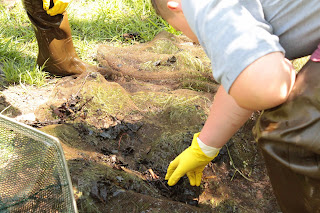How are we connected? There are food chains and webs. There are food choices that drive what we and others will grow and raise, affecting what species exist because we will eat them and which won't because they are considered pests or their food or habitat has been polluted or taken away.
There is a creek that runs between the elementary school I teach at to a park on the town border and beyond. Over the last three years, my third grade students and fifth grade students have monitored the creek for water quality and biodiversity. At our end, there is sediment and run off, tolerant black fly larva and leeches, and an occasional snapping turtle that tries to lay eggs in the school yard. Around the creek are black locust trees, sassafras, sweet pepper bush, oak and maple, luna and cecropia moth, fireflies, and ants making their way through this shady area.
This year, fourth graders did a site assessment for an animal habitat design, measuring their imagined perimeter with their feet heel to toe. Some made a diamond shape, imagining a baseball field. Some others wanted carrots and sunflowers. I explained back in our classroom that we already had those in our sunny school garden and wide-open field, and this was a shady habitat to bring in animals. We talked about the deer who crossed the creek at night. I showed them spicebush and the spicebush caterpillar. We went over a master plant list that included the spicebush, high bush blueberry, hay scented ferns, solomon seal, red columbine, and wooly blue violet. We imagined moths and butterflies and maybe some toads. They took their sloppy copies and moved on the color-coded grids and watercolors.
And then they built it... By next year, we will know if the three grants I'm applying for will allow us to build this for real.
Meanwhile, we imagine and dream.
But today, we travelled. Three third grade classes and a special needs class of third and fourth graders walked along the creek, lead by Sandra from the Barrington Land Conservation Trust, down the path through the woods cleared by ASRI, across the shopping plaza, across four lanes of traffic with the help of Officer Peter, down a street, through more woods, and out into a field and small pond at the other end of the creek. Along the two miles, we saw the signs third graders designed last year hanging around the culverts and street-accessible areas of the creek. Was I imagining it, or was there far less trash going through the shopping plaza now?
Now we were at the park. A painted turtle sunned itself on a rock. I got a quick picture before the kids scared it off.
"We survived!" a lot of them shouted. What an adventure hiking two miles through suburbia with our sneakers and long pants, our backpacks with lunches and bottled water! We laid out tarps and started our picnic, several kids selecting a large rock to dine on and a few electing to sit in the grass.
Then the eighth graders from another school joined us with their science teacher to teach us about water quality and creek animals. They would be running two of our six 15 minute stations for the next hour and a half. We cleaned up our lunches, got in our groups, and began.
At the creek, kids measured oxygen in water and looked at the critters brought in with nets and seines by the eighth graders in tall boots.
I blew the whistle and it was time to rotate.
Here the third graders, guided by the eighth graders, assess water quality through the presence of species with different pollution tolerances.
Whistle blows, and we're looking for evidence of animals: tracks, scat or frass, food remains, burrows, nests, and galls (plant swellings caused by insects laying eggs inside stems or leaves). They found a squirrel nest, several holes in the trees, eaten acorns, a pizza crust. We discussed what animals may have made which homes or left behind certain foods, including us. I described frass (insect droppings) as looking like sawdust (which is true of beetles), corrected them on the "scat" which turned out to be a banana peel or clumped up grass clippings. We also saw many ants, one of which was carrying a caterpillar, and another a spider!
 |
| A firefly lands on our clip boards. |
 |
| Ants are everywhere! |
 |
| Acorn shell. Could there be squirrels? |
 |
| Black feather. Crow? |
 |
| We watched this Braconid wasp preen itself on someone's hat. Tiny wasps like this are often parasitoids, laying eggs on caterpillars that then hatch and eat the caterpillar alive. This one I believe is Earinus limitaris. Wasps like this keep pest populations in check, attacking tomato hornworm and tent caterpillars. |
 |
| Don't forget to look up! |
 |
| Look at holes, but don't put anything inside them! |
Whistle blows! Clip a picture to your shirt and join the food web!
Whistle blows again! Take turns being a mosquito, a frog, and a heron in a fast-paced food-chain tag game!
And again! Guess the parents of familiar and bizarre baby animals, from tadpole to damselfly nymph!
Return to the school, with lighter packs and minds full of wonder. How many connections were made today?


































No comments:
Post a Comment